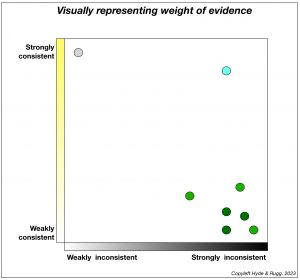We’ve applied the methods and concepts on this site to a wide range of fields. The image below shows an example, where we have used a visual representation that helps de-bias decision making by showing the overall weight of evidence for and against a claim.

In this hypothetical example, there is one piece of weak anecdotal evidence (light grey circle) that is strongly consistent with the claim. There is one piece of weak evidence from a field study (light turquoise circle) that can be viewed as strongly consistent or strongly inconsistent with the claim, because the evidence is ambivalent. There are several strong pieces of evidence from medium and large scale experiments (medium and dark green circles) that are all strongly inconsistent with the claim.
Systematic novel combinations of methods and concepts such as this give swift, practical new ways of tackling problems across many fields.
Content analysis, including visual analysis of texts. If you’re trying to make sense of a large quantity of text, the methods described at the link provide a range of solutions, from traditional content analysis to causal assertions and spatial analysis.
Data collection, market research and related fields, including requirements gathering. We draw heavily on the ACRE framework by Neil Maiden and Gordon Rugg, which provides a systematic way of selecting appropriate methods to elicit different types of explicit, semi-tacit and strictly tacit knowledge.
Design, including user-centred design, person-centred design, and more. We have particularly focused on ways of combining design with human factors and with methods to find what people really want, particularly when they have trouble expressing their wants in words.
Education, including our framework for mapping different education methods onto different types of knowledge. This provides a new way of systematically choosing and using appropriate methods. This framework also provides a systematic linkage between craft skills, training, and academic formal education.
Idea generation, taking a systematic approach to producing, developing, and selecting ideas. This is designed to be combined with the ACRE framework to identify gaps where new ideas are needed, and with standard process management methods once the chosen ideas have been agreed.
Outdoor and indoor non-verbal wayfinding, systematically using design features to help people find their way. This includes use both of visual landmarks and of landmarks that work with other senses, such as smell and hearing. It is designed to be seamlessly integrated with landscaping and decoration strategy.
Representation, using different ways of presenting information to give better insights. The diagram opposite shows one example, where visually showing all the pieces of evidence reduces the risk of people being swayed by one colourful but misleading and weak claim.
Requirements and design, combining elicitation methods for finding requirements with concepts that help in the bigger picture of design. These include sociotechnical issues; reducing the risk of human error; modelling pedestrian traffic flows; and assessing the usability of a design.